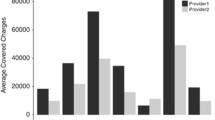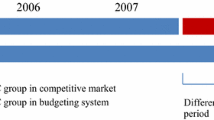Abstract
Costs and prices per patient admission vary greatly across patients and across hospitals. The variance across hospitals is due in part to institutional differences—hospital size, teaching status, local labor costs, and so on—but also to differences in different hospitals' patients' conditions. For purposes of reimbursement under the Medicare program, differences in patients' conditions are typically accounted for by nothing more than noting their different DRGs, without regard to intra-DRG patient differences. My results, which are based on 3.6 million individual patients, show that differences in individual patient DRGs and in observable indicators of their conditions are more than just relevant or important: They are nearly dispositive, explaining over 80% of the total variation in net price per patient admission. Moreover, cross-DRG differences explain only half of that price variation, with the other half explained by patient-level intra-DRG differences in patient condition that are not accounted for by patients' DRG classifications. Further analysis shows that those hospitals that tend to attract the more complex DRGs tend also to attract those patients who are more expensive to treat within each of their DRGs.
Similar content being viewed by others
References
Aitchison, J. and J. A. C. Brown. (1963). The Lognormal Distribution. Cambridge: Cambridge University Press.
Averill, R. F. et al. (1992). “A Study of the Relationship Between Severity of Illness and Hospital Cost in New Jersey Hospitals. ” Health Services Research 27, 587-606.
Barzel, Y. (1976). “An Alternative Approach to the Analysis of Taxation. ” Journal of Political Economy 84, 1177-1197.
Buckle, J. M. et al. (1992). “Severity of Illness and Resource Use Differences Among White and Black Hospitalized Elderly. ” Archives of Internal Medicine 152, 1596-1603.
Cowing, T. G., A. G. Holtmann and S. Powers. (1983). “Hospital Cost Analysis: A Survey and Evaluation of Recent Studies. ” In R. M. Scheffler and L. Rossiter (eds.), Advances in Health Economics and Health Services Research (Vol. 4). Greenwich: J.A.I. Press.
Cowing, T. G. and A. G. Holtmann. (1983). “Multiproduct Short-Run Hospital Cost Functions: Empirical Evidence and Policy Implications from Cross-Section Data. ” Southern Economic Journal 49, 637-653.
Dranove, D. (1987). “Rate-Setting by Diagnosis Related Groups and Hospital Specialization. ” Rand Journal of Economics 18, 417-427.
Dranove, D. and R. Ludwick. (1999). “Competition and Pricing by Nonprofit Hospitals: A Reassessment of Lynk's Analysis. ” Journal of Health Economics 18, 87-98.
Dranove, D., M. Shanley and W. D. White. (1993). “Price and Concentration in Hospital Markets: The Switch from Patient-Driven to Payer-Driven Competition. ” Journal of Law & Economics 36, 179-204.
Epstein, A. M., R. S. Stern and J. S. Weissman. (1990). “Do the Poor Cost More? A Multihospital Study of Patients’ Socioeconomic Status and Use of Hospital Resources. ” The New England Journal of Medicine 322, 1122-1128.
Federal R., Vol. 65, no. 148. (August 1, 2000).
Friedman, B. and M. V. Pauly. (1983). “A New Approach to Hospital Cost Functions and Some Issues in Revenue Regulation. ” Health Care Financing Review 4, 105-114.
Galloro, V. (2001). “Learning a Valuable Lesson: Teaching Hospitals Still Beating Their Nonteaching Counterparts in Medicare Margins. ” Modern Healthcare 31, 6.
Gardner, G. (2000). “More DRGs, Please: MedPAC Plan to Better Account for Severity of Illnesses Faces Uphill Battle. ” Modern Healthcare 30, 6.
Gaynor, M. and G. F. Anderson. (1995). “Uncertain Demand, the Structure of Hospital Costs, and the Cost of Empty Hospital Beds. ” Journal of Health Economics 14, 291-317.
Grannemann, T. W., R. S. Brown and M. V. Pauly. (1986). “Estimating Hospital Costs: A Multiple-Output Analysis. ” Journal of Health Economics 5, 107-127.
Horn, S. D. (1983). “Does Severity of Illness Make a Difference in Prospective Payment?” Healthcare Financial Management 37, 49-52.
Horn, S. D. et al. (1985). “Interhospital Differences in Severity of Illness: Problems for Prospective Payment Based on Diagnosis-Related Groups (DRGs). ” The New England Journal of Medicine 313, 20-24.
Hornbrook, M. C. and A. C. Monheit. (1985). “The Contribution of Casemix Severity to the Hospital Cost-Output Relation. ” Inquiry 22, 259-271.
Iezzoni, L. I. (1997). “Major Teaching Hospitals Defying Darwin. ” The Journal of the American Medical Associ-ation 278, 520.
Iezzoni, L. I. et al. (1990). “Illness Severity and Costs of Admissions at Teaching and Nonteaching Hospitals. ” The Journal of the American Medical Association 264, 1426-1431.
Iezzoni, L. I. et al. (1988). “Admission MedisGroups Score and the Cost of Hospitalizations. ” Medical Care 26, 1068-1080.
Iezzoni, L. I. et al. (1991). “Admission and Mid-Stay MedisGroups Scores as Predictors of Hospitalization Charges. ” Medical Care 29, 210-220.
Kominski, G. F. and S. H. Long. (1997). “Medicare's Disproportionate Share Adjustment and the Cost of Low-Income Patients. ” Journal of Health Economics 16, 177-190
Keeler, E. B. (1990). “What Proportion of Hospital Cost Differences is Justifiable?” Journal of Health Economics 9, 359-365.
Keeler, E. B., G. Melnick and J. Zwanziger. (1999). “The Changing Effects of Competition on Non-Profit and For-Profit Hospital Pricing Behavior. ” Journal of Health Economics 18, 69-86.
Kennedy, P. (1998). A Guide to Econometrics. Cambridge: MIT Press.
Kmenta, J. (1997). Elements of Econometrics. Ann Arbor: University of Michigan Press.
Kominski, G. F. and T. Rice. (1994). “Should Insurers Pay the Same Fees Under an All-Payer System?” Health Care Financing Review 16, 175-189.
Lynk, W. J. (1995). “Nonprofit Hospital Mergers and the Exercise of Market Power. ” Journal of Law & Economics 38, 437-461.
Lynk, W. J. and L. R. Neumann. (1999). “Price and Profit. ” Journal of Health Economics 18, 99-116.
Manheim, L. M. and J. Feinglass. (1994). “Hospital Cost Incentives in a Fragmented Health Care System. ” Topics in Health Care Financing 21, 24-36.
Manning, W. G. (1998). “The Logged Dependent Variable, Heteroscedasticity, and the Retransformation Problem. ” Journal of Health Economics 17, 283-295.
Medicare Payment Advisory Commission. (June 2000). Report to the Congress: Selected Medicare Issues.
Melnick, G. A., C. A. Serrato and J. M. Mann. (1989). “Prospective Payments to Hospitals: Should Emergency Admissions Have Higher Rates?” Health Care Financing Review 10, 29-39.
Melnick, G. A. et al. (1992). “The Effect of Market Structure and Bargaining Position on Hospital Prices. ” Journal of Health Economics 11, 217-233.
Melnick, G. A. et al. (1992). “The Effects of Market Structure and Bargaining Position on Hospital Prices. ” Journal of Health Economics 11, 217-233.
Munoz, E. et al. (1985). “The Financial Effects of Emergency Department-Generated Admissions Under Prospec-tive Payment Systems. ” The Journal of the American Medical Association 254, 1763-1771.
Newhouse, J. P. (1989). “Do Unprofitable Patients Face Access Problems?” Health Care Financing Review 11, 33-42.
Noether, M. (1988). “Competition Among Hospitals. ” Journal of Health Economics 7, 259-284.
Pauly, M. V. (1980). Doctors and Their Workshops: Economic Models of Physician Behavior. Chicago: University of Chicago Press.
Phelps, C. E. (1992). Health Economics. New York: HarperCollins.
Rosenthal, G. E. and C. S. Landefeld. (1993). “Do Older Medicare Patients Cost Hospitals More? Evidence from an Academic Medical Center. ” Archives of Internal Medicine 153, 89-96.
Rosko, M. D. and C. E. Carpenter. (1994). “The Impact of Intra-DRG Severity of Illness on Hospital Profitability: Implications for Payment Reform. ” Journal of Health Politics, Policy and Law 19, 729-751.
Shwartz, M. et al. (1996). “The Importance of Comorbidities in Explaining Differences in Patient Costs. ” Medical Care 34, 767-782.
United States General Accounting Office. (1994). Hospital Costs: Cost Control Efforts at 17 Texas Hospitals. GAO/AIMD-95-21.
Vita, M. G. (1990). “Exploring Hospital Production Relationships with Flexible Functional Forms. ” Journal of Health Economics 9, 1-27.
Vitaliano, D. F. (1987). “On the Estimation of Hospital Cost Functions. ” Journal of Health Economics 6, 305-318.
White, H. (1980). “A Heteroscedasticity-Consistent Covariance Matrix Estimator and a Direct Test For Het-eroscedasticity. ” Econometrica 48, 817-838.
Zuckerman, S., J. Hadley and L. Iezzoni. (1994). “Measuring Hospital Efficiency with Frontier Cost Functions. ” Journal of Health Economics 13, 255-280.
Author information
Authors and Affiliations
Rights and permissions
About this article
Cite this article
Lynk, W.J. One DRG, One Price? The Effect of Patient Condition on Price Variation Within DRGs and Across Hospitals. International Journal of Health Care Finance and Economics 1, 111–137 (2001). https://doi.org/10.1023/A:1012874527253
Issue Date:
DOI: https://doi.org/10.1023/A:1012874527253




